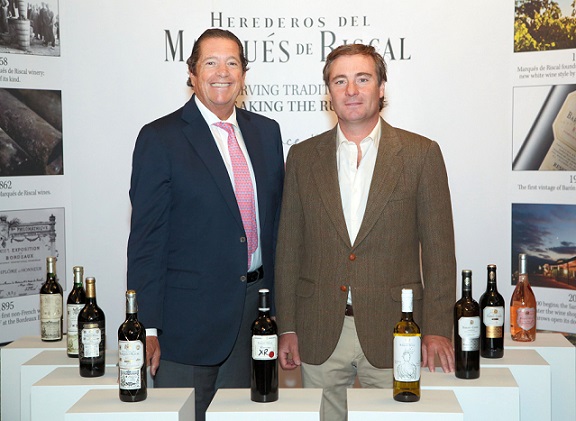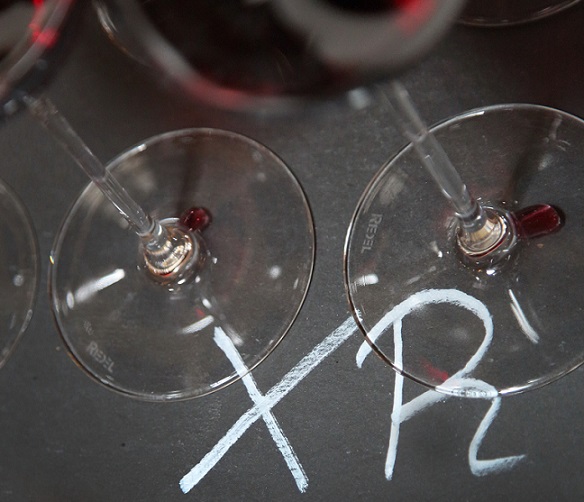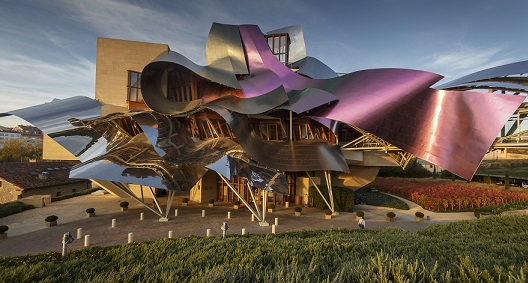It’s an imaginative twist – adding freshness, complexity and boosting the fruit aromas. Unusually, Luis Hurtado de Amézaga Hamparzoumian, technical director of Marqués de Riscal, also insists on using grapes from the estate’s top sites for this rosé.
The Garnacha and Tempranillo grapes come from Riscal’s best ungrafted old vines from the highest gravelly terraces above the River Duero.
“When they asked me to produce a high quality rosé wine a couple of years ago, I thought the first thing to do was to find the right vineyard and the right place to produce this kind of wine,” Luis said. “Traditionally, we’ve been producing rosé wines with the second quality crop – grapes that didn’t have enough colour to produce a good quality red wine.
“But in this case I’ve chosen one of our best vineyards in Toro – ungrafted, old vines of Tinta de Toro (the local name for Tempranillo) and Grenache.”

The wine is the Marqués de Riscal Viñas Viejas. We tasted the 2017 together, although it’s the 2018 vintage that’s currently on the market, as Luis wanted to show its potential for ageing.
It is still very bright and lively, largely due to the few months’ contact with the fine lees of Sauvignon Blanc.
The fine lees from the 75% Garnacha and 25% Tempranillo are replaced with that of Sauvignon Blanc once the fermentation of the free-run juice has finished. “That gives an extra character to the wine, much more acidity, and much more intensity on the nose,” Luis said. “I’ve been doing this because the Grenache in Toro – if I had to pick it earlier to keep the natural acidity, the aroma is a bit grassy. I wanted to have more citrus character in this type of wine.”
Darker in colour than many rosé wines, Luis likes to think it has “the spirit of red wine”.
The details
Varieties: 75% Garnacha, 25% Tinta de Toro (the local name for Tempranillo)Alcohol: 14%
Total acidity: 5.6
pH: 3.25
Residual sugar: <2g/L
Winemaking:
- Whole bunch pressed
- Free-run juice only
- The Grenache goes straight into stainless steel tanks
- The Tempranillo goes into 600L French oak barrels for three or four months

Marqués de Riscal launches XR
Luis talked about the rosé during the launch of Marqués de Riscal’s new Rioja – the XR.XR stands for ‘Extra Reserva’ and goes “beyond the Rioja boundaries of Gran Reservas and Reservas to pioneer a new label and age category”, according to de Riscal.
Dating back to the 19th century, Marqués de Riscal’s first-generation winemakers would chalk ‘XR’ on barrels of wine with special characteristics. This is a first time XR wines have been released onto the market, and the production of 15,000 bottles is being made available exclusively to the on-trade at this stage.
The wine is made from old vines in Elciego in Rioja Alavesa.
The first release, the XR Reserva 2015, is a blend of 91% Tempranillo and 9% Graciano, which adds spiciness and high natural acidity to the blend.
The wine was aged for 26 months in American barriques with between 10% and 15% of the wine aged in new barrels for six months.
Luis said they always try to source grapes for their Reservas from vines that are more than 50 years old because the plant material is much better for long-lasting wines – these vines producing smaller berries and smaller bunches.
The estate is shifting to organic farming, with 350ha of 500ha of the Rioja vines it uses now certified organic. “I think organic viticulture is absolutely necessary, not only for the flavour of the wines but for the healthiness of everybody and also to maintain our vines for a longer period of time,” Luis said.

Another shift is towards less intervention in the winery.
“We have to produce low-intervention wines to respect all of the personality of the land and the personality of all these very special local varieties,” Luis told Canopy. “We are trying to work with less sulphur for sure. For that we need beautiful acidity – a low pH. I’m not talking about producing wines without any SO2, because I think that’s crazy but we can moderate the doses of sulphur nowadays.”
One of the keys to achieving this is “to be more precise when harvesting,” Luis said. “We harvest part of the crop when it has a low pH and high acidity, and use it as part of blend.
“Natural acidity in organic wines is the key. When the pH is low the sulphur is much more active.”
He said the Sauvignon Blanc has 60mg/L total SO2 and 22mg/L free.
XR Reserva 2015
Varieties: Tempranillo 91%, Graciano 9%pH: 3.56
Alcohol: 14.4%
Ageing: 26 months in American oak












.png)






